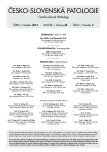A fatal case due to cough syrup abuse
Fatální případ abusu sirupu proti kašli
Popsán fatální případ abúzu sirupu proti kašli, obsahující chlorpheniramin a dihydrokodein. Koncentrace chorpheniraminu po smrti byla v krvi nad smrtící úrovní, ale koncentrace dihydrokodeinu byla v terapeutickém pásmu a tyto hodnoty byly diskutovány z hlediska forenzní farmakokinetiky. Usuzujeme, že příčinou smrti byla otrava chlorpheniraminem.
Klíčová slova:
abusus sirupu proti kašli – chlorpheniramin – dihydrokodein
Authors:
H. Kinoshita; N. Tanaka; M. Jamal; M. Kumihashi; R. Okuzono; K. Ameno
Authors place of work:
Department of Forensic Medicine, Faculty of Medicine, Kagawa University
Published in the journal:
Soud Lék., 57, 2012, No. 4, p. 69-70
Category:
Původní práce
Summary
We describe here a fatal abused case of cough syrup, containing chlorpheniramine and dihydrocodeine. Postmortem blood concentration of chlorpheniramine was above fatal levels, but dihydrocodeine concentration was within a therapeutic ranges, and those drug levels in blood were discussed from the viewpoint of forensic pharmacokinetics. We concluded that the cause death was due to the chlorpheniramine poisoning.
Keywords:
cough syrup abuse – chlorpheniramine – dihydrocodeine
In a case of death by drug abuse, forensic toxicologists should consider the scientific proof. There may be a long delay between the drug intake and death, during which time the blood or tissue level may decline (1). It may be essential to have markers of drug abuse following use over a relatively long term. Bron® is an over-the-counter cough syrup sold in Japan, and it is sometimes abused (2). Here we report a fatal case of cough syrup abuse.
CASE HISTORY
A female in her thirties (160cm, 60kg) was found dead in her bed. Subsequent investigation by the authorities revealed that there were 22 empty bottles of New Bron® Solution-Ace around her. This medicine contains 60mg of dihydrocodeine phosphate and 24mg of chlorpheniramine maleate per bottle (120ml) (2).
A medico-legal autopsy revealed no evidence of external injury, nor findings of natural disease. Both lungs showed severe edema and congestion. Slight cerebral edema was also observed. Toxicological analysis showed that concentrations of dihydrocodeine and chlorpheniramine in the femoral blood were 0.054 μg/ml and 2.4 μg/ml, respectively. No ethanol was detected in the blood.
DISCUSSION
Blood concentrations following therapeutic dose of dihydrocodeine and chlorpheniramine ingestion range between 0.03–0.25 μg/ml and 0.01–0.017 μg/ml, respectively, while fatal levels are those above 0.7–12 μg/ml and 0.5–1.1 μg/ml, respectively (3,4). In the present case, the postmortem concentrations of chlorpheniramine was above fatal levels, but dihydrocodeine concentration was within a therapeutic ranges.
Because the elimination half-life of dihydrocodeine (3.4–4.5hr) (5) is shorter than that of chlorpheniramine (12–43hr) (5), chlorpheniramine had accumulated in her blood. The concentration difference between dihydrocodeine and chlorpheniramine may be reflected the frequent intake of cough syrup over a relatively long term. Although the details of her history of abuse was unknown, accumulation of chlorpheniramine in blood may be an important findings of Bron® abuse.
Chlorpheniramine, a first-generation antihistamine, has anticholinergic effects and produces excitatory effects on central nervous system when taken in overdose (6). Convulsion is sometimes observed as an adverse effect of stimulating the central nervous system (7). In case of poisoning, it causes deep coma with cardio-respiratory collapse and death, terminally (6).
We have also estimated the victim’s total amounts of ingestion of New Bron® Solution-Ace. Using values of the distribution volume (Vd) for dihydrocodeine (1.0–1.3 L/kg) and for chlorpheniramine (3–6 L/kg) (5), the victim’s body weight and femoral blood levels, the calculated amounts of dihydrocodeine and chlorpheniramine were 3.2–4.2mg and 432–850mg, respectively. The estimated total amount of chlorpheniramine was equivalent to the contents of chlorpheniramine maleate in at least 25 bottles of New Bron® Solution-Ace.
CONCLUSION
From the autopsy findings and the results of the toxicological examination, we concluded that the cause of her death was due to the chlorpheniramine poisoning. Chlorpheniramine may become a reliable marker of Bron® abuse.
Correspondence address:
Dr. H. Kinoshita,
Department of Forensic Medicine
Faculty of Medicine, Kagawa University,
1750-1, Miki, Kita, Kagawa, 761-0793, Japan
tel.: +81-87-891-2140 fax: +81-87-891-2141
e-mail: kinochin@med.kagawa-u.ac.jp
Zdroje
1. Saukko P, Knight B. Knight’s Forensic pathology, (3rd ed). London, Hodder Arnold: 2004.
2. Taguchi H, Suyama M, Misumi S, Senoo E. Mental disorders induced by the over-the-counter antitussive syrups not containing methylephedrine. Jap J Clin Psychiatry 2002; 31 : 1107–1117.
3. Reed D. A fatal case involving chlorpheniramine. Clin Toxicol 1981; 18 : 941–943.
4. Winek CL, Wahba WW, Winek CL Jr, Balzer TW. Drug and chemical blood-level data 2001. Forensic Sci Int 2001; 122 : 107–123.
5. Baselt RC. Disposition of toxic drugs and chemicals in man, (8th ed). Foster City, CA: Biochemical Publications: 2008
6. Skidgel RA, Erdös EG. Histamine, bradykinin and their antagonists. In: Brunton LL, Lazo JS, Parker KL. eds. Goodman & Gilman’s The pharmacological basis of therapeutics (11th ed). New York, McGraw-Hill: 2006, pp. 629–651.
7. Murao S, Manabe H, Yamashita T, Sekikawa T. Intoxication with over-the-counter antitussive medication containing dihydrocodeine and chlorpheniramine causes generalized convulsion and mixed acidosis. Inter Med 2008; 47 : 1013–1015.
Štítky
Patologie Soudní lékařství ToxikologieČlánek vyšel v časopise
Soudní lékařství

2012 Číslo 4
Nejčtenější v tomto čísle
- Fatální případ abusu sirupu proti kašli
- Náhlé úmrtí při vzácném mozkovém nádoru: Případ z pitvy
- Dvojí výročí v českém soudním lékařství
- Neobvyklé poranění hlavy a krku ve výtahu

